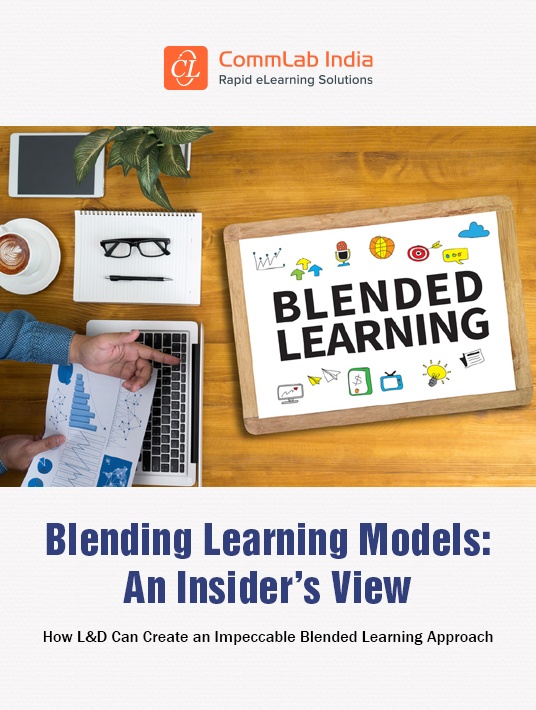Blended Learning Solutions For Challenging Situations
While we’ve explored most of the aspects of blended learning—from benefits to models, and from best practices to pitfalls—there is one aspect we haven’t explored, and that is how to find the right proportion of delivery methods in a blend, how much of what should be used, and when.

This can be even more difficult in situations where:
|
The challenge is to design effective blended learning solutions in such "not so uncommon" situations.
We all know about blended learning solutions for different types of training (safety, sales, compliance, onboarding) but let’s now look at customized blended solutions that specifically cater to your unique situational challenges, such as those above.
1. When Classroom Training Is Not Economically And Logistically Practical
If you have a large audience that is widely spread across the globe, it’s certainly tough to organize classroom training. In addition, if you already have budgetary constraints, the cost of hiring instructors who can speak in the native languages of learners will be an additional burden. What’s more, the cost of travel, venue, food, and classroom materials will all add up!
So, how should you plan your blended learning solution keeping in mind these constraints?
That’s easy. Your blended learning solution should include more digital training methods to reduce the costs of classroom training.
eLearning or VILT (Virtual Instructor-Led Training), supported by digital assets—videos, assessments [1], simulations, social learning, and so on—should account for 70% of your blended learning solution while the remaining 30% can be delivered using in-person training. This will minimize the costs for travel, venue, food, and so on, all associated with in-person classroom training.
Here’s an example of how your blended learning should look like when budget and logistics are a problem.
| Method | Reason for using |
| eLearning | As formal training to disseminate information/knowledge about the subject matter, consistently. |
| VILT | This digital alternative for face-to-face, Instructor-Led Training (ILT) can be used to explain complex topics, clarify doubts, and address questions. |
| Online assessments | For effective learning evaluation after each learning point (formative) and at the end of a course (summative). Learners’ progress can be monitored and tracked using a Learning Management System (LMS). |
| Collaborative activities on virtual platforms | To retain the essence of in-person classroom interactions. Breakout rooms can be used to assign group activities. |
| Microlearning assets | To offer summaries (as videos) and key takeaways (as infographics), reinforce what’s learned (as game-based nuggets), and test practical knowledge (as scenarios). |
2. When The Subject Is Difficult To Learn, Retain, And Apply
How should your blended learning solution address a subject that is difficult to learn, retain, and apply? This can be about complex machinery, handling chemicals, healthcare and pharmaceutical solutions, petrochemicals, and so on. In such situations, your blended learning solution should include more of in-person classroom instruction than online methods.
ILT methods should account for at least 70% of the entire blended learning program, while the remaining 30% can be digital training. This ensures your learners have the constant support of an instructor to help their learning and clarify doubts as soon as they arise. This will also prevent the misunderstanding of the subject and provide scope for practice.
Here’s what your blended learning solution for a difficult subject should look like.
| Method | Reason for Using |
| Online pre-assessments | To gauge learners’ existing knowledge and identify gaps where the learner needs to focus on. |
| ILT sessions/Webinars | As formal training to explain complex topics and address learners’ needs to ensure there are no learning gaps. |
| eLearning assessments | To evaluate learners’ knowledge at the end of the training. Test results can be used to identify areas needing further training support. |
| Coaching | To help apply learning to real-life situations and challenges and address learning gaps identified from assessment results. |
| Workshops | To offer opportunities for hands-on practice before real-life application. Real-time feedback ensures reinforcement of the right knowledge. |
| Online refresher courses | To ensure long-term retention of knowledge and effective on-the-job application. "How-to" videos can be used for demonstrations and simulation-based modules for practice. |
3. When Learning Includes Both Knowledge And Skills
For tasks requiring proficiency in both knowledge and skills, such as ERP software, safety, patient care, and so on, the blended solution must include equal amounts of ILT and digital methods to leverage the best of both modalities. The knowledge aspect can be covered by eLearning, and skills can be taught in the classroom to ensure effective on-the-job application.
How should you go about designing the blended learning program to cover both the knowledge and skill aspects of learning?
We suggest going with the flipped classroom strategy, a reverse of the conventional classroom training model where instruction is provided before the classroom training.
Here’s how you can use the flipped classroom in blended learning.
| Method | Reason for using |
| Initial online training | Learners go through self-paced eLearning first to understand the concepts. Videos may also be used to demonstrate topics that can be better understood visually. Online discussion forums may be used to solidify the concepts. |
| Classroom sessions | Classroom time is used effectively by the trainer to provide deeper insights into topics learners need assistance with. The sessions can include hands-on practice activities under the supervision of the trainer. |
| Performance-based assessments | Performance-based assessments with learners having to actually perform a task are included to evaluate both the knowledge and skills of learners. |
| Periodic training | Periodic training through VILT, ILT, eLearning modules or workshops helps refresh learners’ knowledge and the skills required for effective performance. |
4. When SMEs And Trainers Are Overburdened
There are times when your Subject Matter Experts and trainers are overburdened with critical business responsibilities. In such situations, your blended learning solution should aim to make the most of whatever time the SME can spare for training.
Let’s look at how to maximize the limited time of SMEs/trainers through a blended learning approach [2].
| SME/Trainer | Tips to save time |
| SMEs |
|
| Trainers |
|
5. When Learners Are Situated In Remote Locations
You might be wondering how to include in-person training when learners are situated in remote locations, such as retail outlets, coal mines, or oil rigs. While this might seem contradictory, it is possible to design an effective blended learning solution for a remote workforce. However, a major portion of the training will be delivered online.
Here’s how your blended learning solution can be designed for a remote workforce [3].
| Method | Reason for use |
| Introductory eLearning module | Include self-paced eLearning courses to apprise learners of the basic concepts of the subject. This would ensure adequate preparation before the VILT session with the instructor. |
| VILT | Use virtual platforms to conduct Instructor-Led Training sessions. Chat, polls, screen sharing, breakout rooms, and whiteboards enable engaging sessions without losing the essence of in-person interactions. |
| eLearning assessments | Test learner understanding and knowledge. |
| Microlearning modules | Microlearning assets can be used to refresh training concepts from time to time. |
| Workshops | In-person workshops once every few months help learners hone their practical skills. Learners can refresh previous learning and also learn new skills under the supervision of the instructor. |
It’s Wrap Time!
These are the blended learning solutions for just 5 challenging situations. There can be many other situations where blended learning solutions can be tried if nothing else works. Thanks to technological advancements, creating hybrid blended solutions is no longer a problem. However, the key is to ensure a right proportion of in-person and technology-driven training methods in your blended solutions [4].
Download our eBook An Insider's View On Blending Learning Models: How L&D Can Create An Impeccable Blended Learning Approach to discover how blended learning enhances training, the best blended models, tips for successful implementation, and more. Also, join the webinar on blended learning to discover new solutions to old problems.
References:
[1] 3 Effective Formats for Performance-based Assessments: What’s Your Pick?
[2] In-House SME, Too Busy; External SME, Too Elusive: A Catch-22
[3] Strengthening an ‘Accidental’ Remote Workforce During COVID-19 Times
[4] How Can Technology-Enabled Learning Harness the 70:20:10 Model for L&D?








